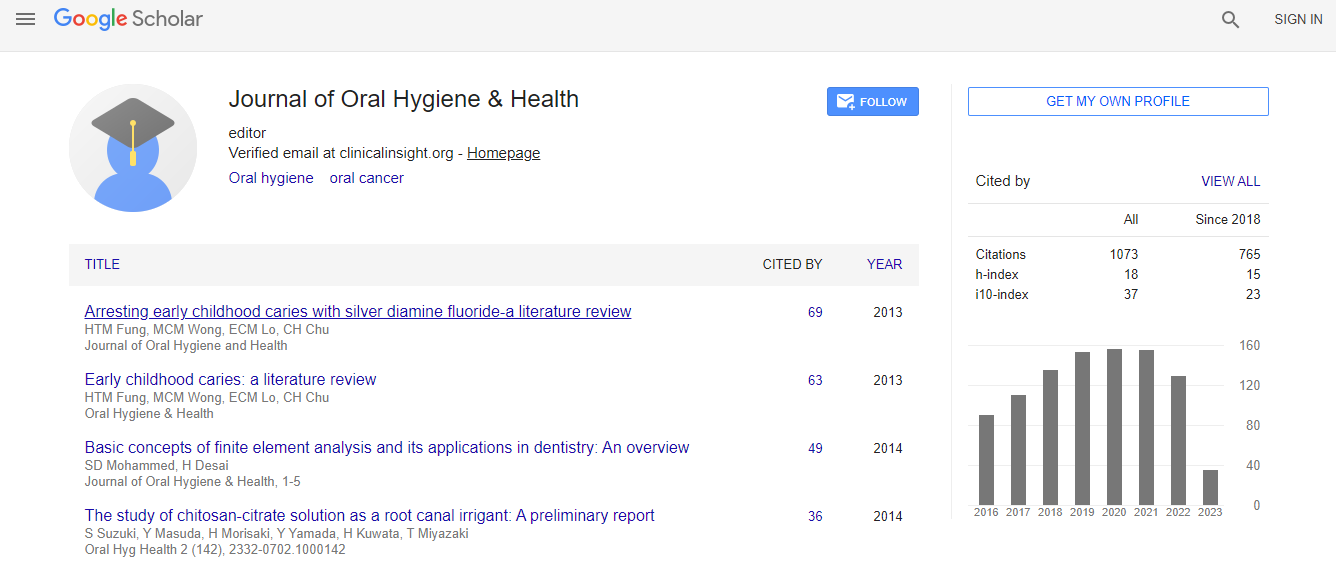Research Article
Regeneration of Pulp/Dentin-Like Tissue in Immature Necrotic Permanent Dog Teeth Using Adipose Tissue-Derived Mesenchymal Stem Cells
Najlaa MA1*, Eman AEA1,2, Ibrahim MM3, Hazem MA4, Khaled HEA5 and Douaa AED1,61Pediatric Dentistry Department, Faculty of Dentistry, King Abdulaziz University, Jeddah, Kingdom of Saudi Arabia
2Pedodontic Department, Faculty of Dental Medicine (Girls), El Azhar University, Cairo, Egypt
3Department of Orthodontics, Ibrahim Masoud Dental Speciality Clinic, Jeddah, Kingdom of Saudi Arabia
4Clinical Biochemistry Department, Faculty of Medicine, Rabigh Branch, King Abdulaziz University, Jeddah, Kingdom of Saudi Arabia and Medical Biochemistry, Faculty of Medicine, Cairo University, Cairo, Egypt
5Oral Radiology Department, Faculty of Dentistry, Umm Al Qura- University, Kingdom of Saudi Arabia, and Ain Shams University, Cairo, Egypt
6Community Medicine and Public Health Department, Cairo University, Faculty of Medicine, Cairo, Egypt
- *Corresponding Author:
- Najlaa MA
Professor, Pediatric Dentistry Department
Faculty of Dentistry, King Abdulaziz University
Jeddah, Kingdom of Saudi Arabia
Tel: +6401000 (22026-20388-22264)
E-mail: nalamoudi2011@gmail.com
Received date: January 05, 2017; Accepted date: March 05, 2017; Published date: March 13, 2017
Citation: Najlaa MA, Eman AEA, Ibrahim MM, Hazem MA, Khaled HEA, et al. (2017) Regeneration of Pulp/Dentin-Like Tissue in Immature Necrotic Permanent Dog Teeth Using Adipose Tissue-Derived Mesenchymal Stem Cells. J Oral Hyg Health 5:217. doi: 10.4172/2332-0702.1000217
Copyright: © 2017 Najlaa MA, et al. This is an open-access article distributed under the terms of the Creative Commons Attribution License, which permits unrestricted use, distribution, and reproduction in any medium, provided the original author and source are credited.
Abstract
Objective: Our aim was to evaluate the potential of adipose tissue-derived mesenchymal stem cells (AD-MSCs) in the regeneration of canal pulp/dentin-like tissue and completion of root maturation of immature necrotic permanent dog teeth with apical periodontitis. Materials and methods: This study is a collaborative work between King Abdulaziz University with, Cairo University, Egypt. A split-mouth design was used in 6 healthy male dogs. Four teeth were selected per dog (total, 24 teeth). The immature upper left second and third permanent incisors were designated as group A (experimental group), and contralateral teeth were designated as group B (control group). Periapical periodontitis was induced in both groups. After disinfection, group A received AD-MSCs and growth factors within a chitosan scaffold, whereas group B received growth factors within a chitosan scaffold. Periradicular healing, root-wall thickening and lengthening, and apical closure were blindly monitored radiographically for 4 months. The animals were euthanized and the teeth examined histologically for healthy pulp/dentin complex-like tissue. Results: Group A showed significantly higher increase in radicular thickening, root lengthening, and apical closure than group B. However, there was no significant difference in apical healing. Histologically, the teeth of group A, but not group B, showed regeneration of pulp/dentin-like tissue. Conclusion: AD-MSCs in conjunction with growth factors incorporated into a chitosan hydrogel scaffold regenerated pulp/dentin-like tissue and facilitated complete root maturation of non-vital immature permanent dog teeth with apical periodontitis.

 Spanish
Spanish  Chinese
Chinese  Russian
Russian  German
German  French
French  Japanese
Japanese  Portuguese
Portuguese  Hindi
Hindi 
